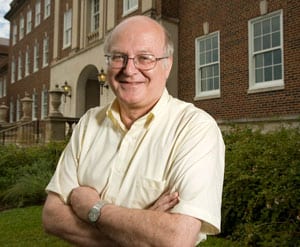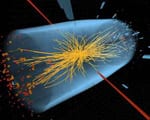The Dallas Observer interviewed SMU physicist Ryszard Stroynowski about Texas’ historic role in particle physics before the landmark discovery announced in July of the new fundamental “God particle” necessary for scientists to explain how matter acquires mass.
The Dallas Observer article, “How Texas Came Within an Atom’s Breadth of Discovering the God Particle,” published Aug. 15.
The discovery results, which are preliminary, were announced July 4 at CERN, the European Organization for Nuclear Research, near Geneva, Switzerland, and at the International Conference of High Energy Physics in Melbourne, Australia. CERN is the headquarters for the LHC lab, which is a collaborative experiment involving thousands of scientists worldwide.
EXCERPT:
By Brantley Hargrove
Dallas Observer
Ryszard Stroynowski sat bathed in the pale glow of his laptop screen. At 2 in the morning of Independence Day, as the final, fugitive firecracker reports of the night crackled across a sleeping Dallas, the 65-year-old physicist was wide awake. As he watched the live broadcast in his pajamas, his colleagues at the European Organization for Nuclear Research (CERN) in Geneva, the locus of the physics universe, tolled the end of the search for an elusive force that had confounded them for half a century. It was the final puzzle piece in a theory that describes with unfathomable precision the fundamental particles of the universe and the laws they obey.This piece, known as the Higgs boson and often referred to in the popular press as “the God particle,” was detected in the largest scientific experiment ever devised. Inside a racetrack-shaped particle accelerator five miles across and spanning the borders of France and Switzerland, researchers had reproduced the first, violent moments of creation. By crossing opposing beams of protons powered by enough electrical current to flash-melt a ton of steel instantaneously, and guided by megalithic magnets ringing the accelerator’s course, researchers induced collisions powerful enough to overcome the elemental forces that bind the proton’s constituents. Out of the flashes of the collisions, they glimpsed the wraith-like field that allowed atoms and molecules, stars and planets, to coalesce out of chaos. What they found helped the shapeless take form.
“As a layman, I would now say I think we have it,” said a beaming Rolf Heuer, director-general of CERN, to the experimenters, the press and to anyone in the world with an Internet connection.
Stroynowski, an avuncular man with a smooth pate, a white corona of hair and pale gray eyes, already knew, had known for months. After all, he had crunched the numbers. He led the design and construction of the major component of a detector heavier than an aircraft carrier and as big as the science building at Southern Methodist University, where he teaches. It was called ATLAS, and it found the Higgs.
Stroynowski knew something else, too, a truth that had irrevocably altered his life, the lives of thousands of physicists and the future of North Texas, if not the state. Once upon a time, a tiny town known for its blackland prairie and cotton fields, just a straight shot south down Interstate 35 from Dallas, was physics’ next frontier. In 1988, Ellis County was selected the winner in a heated nationwide competition to be the site for a particle accelerator that would dwarf the one in Geneva. In size, the leviathan’s circumference would approach D.C.’s Beltway, some 54 miles around; big enough to envelop Waxahachie, and require the extinction of a nearby farming hamlet. The world’s existing accelerators had taken physics as far as they could. The accelerator in Texas, called the Superconducting Super Collider, had the potential to take it further than any theorist could possibly dream, opening doors they could not predict.
Thousands of physicists from all over the world, including Stroynowski, pulled up stakes and migrated to the North Texas site as though it were Mecca, a holy place where the future of the field lay. They established physics departments at nearby universities and began construction of the Super Collider and the components they had to literally invent as they went along. But in 1993, after more than a decade of work and $2 billion spent, Congress canceled it. Its death rendered stillborn American hegemony in the physics world and drove a host of promising young minds from the field. [ … ]
Follow SMUResearch.com on Twitter, http://twitter.com/smuresearch.
SMU is a nationally ranked private university in Dallas founded 100 years ago. Today, SMU enrolls nearly 11,000 students who benefit from the academic opportunities and international reach of seven degree-granting schools. For more information see www.smuresearch.com.
SMU has an uplink facility located on campus for live TV, radio, or online interviews. To speak with an SMU expert or book an SMU guest in the SMU Broadcast Studio, call SMU News & Communications at 214-768-7650.



 Observed! SMU’s LHC physicists confirm new particle; Higgs ‘God particle’ opens new frontier of exploration
Observed! SMU’s LHC physicists confirm new particle; Higgs ‘God particle’ opens new frontier of exploration SMU physicists at CERN find hints of long sought after Higgs boson — dubbed the fundamental “God” particle
SMU physicists at CERN find hints of long sought after Higgs boson — dubbed the fundamental “God” particle Dallas Observer: As Physicists Near Discovery of God Particle, A Word With SMU Prof Involved In the Search
Dallas Observer: As Physicists Near Discovery of God Particle, A Word With SMU Prof Involved In the Search WFAA: Super Collider’s legacy lives on in Switzerland
WFAA: Super Collider’s legacy lives on in Switzerland